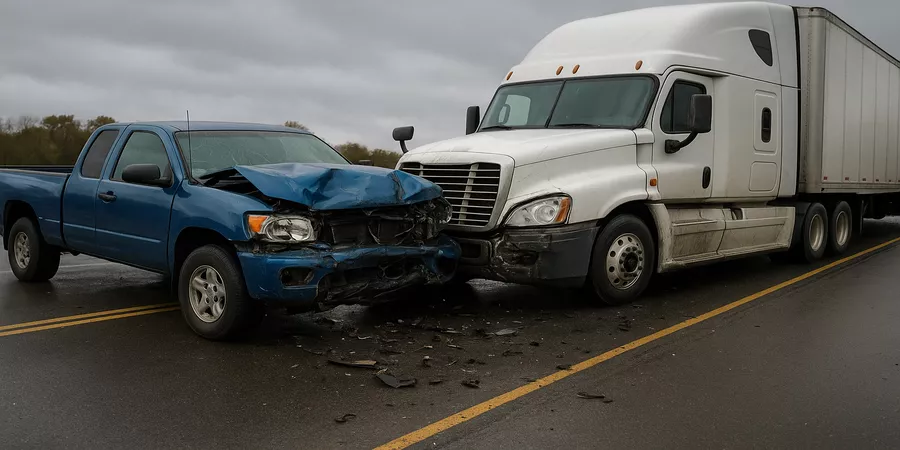The difference between a pickup truck and an 18-wheeler isn’t just visual. It’s physics. A fully loaded semi can weigh 80,000 pounds. A typical passenger car weighs 3,500 pounds. That’s not a slight advantage for the truck, that’s an entirely different force at play.
When a heavy truck hits a lighter vehicle, the outcome isn’t just “worse,” it’s catastrophically different. The laws of motion and momentum don’t care about fairness. More weight means more energy, more destructive force, and more severe injuries.
This fundamental physics principle explains why truck accidents are treated differently from regular car crashes in almost every legal and insurance framework. A semi stopping from highway speed takes the length of multiple football fields because of its mass and inertia.
A passenger car can stop in a fraction of that distance. Understanding these mechanical realities isn’t just trivia about vehicles, it’s the foundation for understanding why truck accidents happen, how they’re investigated, and why liability sometimes flows differently than it does in car-versus-car collisions.
Weight doesn’t just determine crash severity, it shapes regulatory frameworks, liability assignments, and recovery calculations. Recognizing how truck weight functions as a safety factor explains why regulations exist in the first place and why accidents involving heavy trucks are so devastating. Understanding this connection transforms how you see road safety and how accidents get investigated and assigned.
Momentum and Impact
Physics teaches that force equals mass times acceleration. When a loaded 18-wheeler traveling at 55 miles per hour hits a stationary car, the energy transfer is staggering. The semi barely slows down. The passenger car gets devastated. This isn’t because the truck driver was negligent; it’s because physics creates an inherent imbalance. A semi needs roughly 100 feet longer to stop from highway speed compared to a passenger car.
Braking distance matters tremendously in real-world accident scenarios. A truck driver responding to an emergency brake event at 60 miles per hour needs about 300 to 400 feet to bring their vehicle to a complete stop. That’s the length of a football field. A passenger car needs roughly 130 to 150 feet from the same speed. That difference creates accident scenarios that shouldn’t exist. A truck following a passenger car too closely becomes inevitable danger because the truck physically cannot stop as quickly even if the driver reacts perfectly.
The impact energy gets distributed differently too. When a semi hits a passenger car, the car absorbs most of that energy, which translates into severe deformation and injury to occupants. The semi barely feels it. This imbalance is why passengers in trucks involved in collisions with cars suffer dramatically higher injury rates. It’s not just about speed; it’s about the massive difference in mass and how that mass concentrates its destructive force onto smaller vehicles.
The Role of Weight Limits and Scales
States regulate truck weight specifically because of these physics principles. Federal regulations cap gross vehicle weight at 80,000 pounds for most trucks on interstate highways. States can lower those limits within their borders for state highways. These aren’t random numbers; they’re calculated based on road capacity, bridge integrity, and safety research. Heavier vehicles cause more road damage, which costs taxpayers money in maintenance.
Weight enforcement happens through scales at weigh stations and random inspections. Trucking companies face heavy fines if caught exceeding weight limits. Some exceed them anyway because the fines are sometimes cheaper than making multiple trips with legal weight limits. That calculation turns an overloaded truck into a preventable hazard. An 18-wheeler at 82,000 pounds instead of 80,000 might seem minor, but that extra weight increases stopping distance and crash severity.
The enforcement gap matters too. Weigh stations don’t catch every overloaded truck. Rural highways often lack oversight. Late-night driving reduces enforcement presence. Some trucking companies knowingly push weight limits on less-monitored routes. When an accident involves an overloaded truck, that negligence becomes part of the investigation. Proving a truck was overweight at the time of an accident strengthens liability against the driver, the trucking company, and potentially the shipper who loaded the cargo improperly.
Why Weight Affects Liability
Liability in truck accidents gets complicated because multiple parties can share responsibility. The truck driver is always involved, but so is the trucking company that employed them, the company that loaded the cargo, and potentially the shipper who created the overweight load. Weight violations shift liability in ways that don’t happen in standard car accidents.
If an overloaded truck causes an accident, the trucking company bears responsibility for violating weight regulations, even if the driver wasn’t negligent. They should have ensured the truck wasn’t overloaded before leaving the yard. If the cargo wasn’t properly secured and shifts during transit, causing the truck to become unbalanced, the shipper who loaded it becomes partially liable. These liability divisions don’t exist in car accidents because civilians typically aren’t loading cargo into their vehicles.
Maintenance responsibility also connects to weight. Trucks carrying heavy loads need more aggressive maintenance. Brakes, tires, and suspension systems wear faster. A trucking company that skips maintenance on a truck destined for heavy loads creates hazardous conditions that contribute to accidents. An accident involving failed brakes on an overloaded truck might be jointly attributed to the driver, the company’s maintenance failure, and the overweight load itself. Weight creates that cascading liability structure.
Prevention Through Physics Understanding
Recognizing weight as a safety factor changes how both truck drivers and passenger vehicle drivers should behave. Truck drivers need to respect their stopping distance limitations and maintain much larger following distances than passenger car drivers. Passenger car drivers need to avoid lingering in a truck’s blind spots and avoid cutting off trucks that physically cannot respond quickly to emergency situations.
Regulation enforcement matters for safety, not just for revenue. Weigh stations, regular inspections, and enforcement of weight limits genuinely reduce accidents by keeping trucks within physics-safe parameters. When enforcement slackens, accidents increase. This is documented across transportation safety data. The relationship between weight regulation enforcement and accident rates is direct and measurable.
Driver training programs increasingly emphasize weight and physics principles because understanding these mechanics reduces accidents. Drivers who grasp why an overloaded truck can’t stop quickly drive differently than those who just follow rules without understanding the underlying safety reason. Education combined with enforcement creates better compliance and fewer preventable accidents involving heavy trucks.
Conclusion
Truck weight isn’t trivia; it’s a fundamental safety equation with life-and-death stakes. The difference in mass between vehicles creates physics that no amount of driver skill can overcome. Respecting those physical limitations through regulation, enforcement, and driver behavior prevents accidents that otherwise seem inevitable.
Accidents involving heavy trucks happen at a higher severity rate than car-versus-car collisions precisely because of weight differences. Understanding why that’s true moves the conversation from blame to physics. The physics doesn’t care about fault; it just operates based on mass and motion. Accidents happen when people ignore what physics demands.
Recognizing how weight shapes accidents changes how we think about regulation, driver responsibility, and safety. It explains why truck drivers need more training, why weight limits matter, and why trucks need different rules than passenger vehicles. Physics created these requirements long before government regulation formalized them. Understanding that connection reveals how true road safety actually works.














